Writing this blog encourages me to bake much more interesting things than I would usually do. I get stuck making the same few things, but as that would get pretty boring on here I have to find new things (or resurrect old things) in order to be able to continue posting.
It also makes me think about my baking, the other day I posted on Shoo-Fly Pie and, though I have been interested in its origins for some time, I have never looked into it in any depth. My research yesterday, prompted by my post, told me that it is a popular dish amongst the Dutch immigrants in Pennsylvania, USA. There they use molasses (treacle to us Brits), which I think would be a little gooey and strong for my taste. If, however, you would like to try this method then a recipe should be able to be found here.
So, though you may think that this site is purely for the thousands of bakers out there who are looking for inspiration, it is really all for my personal benefit and development as a baker (none of them have managed to find it yet anyway!).
Stay free.
Friday 25 January 2008
Wednesday 23 January 2008
Shoo-Fly Pie
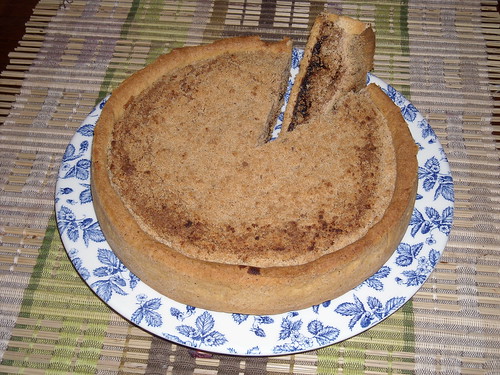 I haven't been baking a lot of puddings recently, just a few cakes every now and then, so my blog has been a bit devoid of sweet treats. This is starting to be remedied with my latest offering, and we are dipping our toes into the world of pastry at the same time.
I haven't been baking a lot of puddings recently, just a few cakes every now and then, so my blog has been a bit devoid of sweet treats. This is starting to be remedied with my latest offering, and we are dipping our toes into the world of pastry at the same time.Shoo-Fly Pie is perhaps my favourite non-chocolate pudding and this recipe has been passed down through my family for some generations. It is a cross between a pie and a crumble, with a dried fruit filing squeezed between a pastry base and a crumble topping. To make it you will first need to have some shortcrust pastry, perhaps the simplest form of pastry, which you can either buy or, as you have lots of flour in your house and it only takes a minute, just follow my simple instructions.
Both these recipes use the 'rubbing in' technique, where the fats and flours are usually rubbed together using fingertips. If, like me, you don't like this method because it gets under the nails, the fats melt from your warm hands or it's just a pain and strain on the fingers, then you can work the two together with a fork (or even in a food processor) which is much easier. It may take some time for you to get used to the quantity of water needed to make a good pastry, but you can't go far wrong, adding flour or water as necessary to make a workable consistency will always provide a perfectly edible pastry. I use self-raising flour because I think it is slightly more forgiving and makes a lighter pastry than the plain variety, but either is acceptable. Leaving it for a few minutes in the fridge always improves it's performance, especially after lining trays, and prevents it shrinking too much during baking.
Once you've got the pastry everything is reasonably straightforward and according to the recipe, my most common error is forgetting to add the spices to the dry flour, which makes it difficult to mix them in later. I'm sure you will not be disappointed with the results, it always goes down well with visitors to my house, many of whom have never heard of/tasted it before.
Sweet.
Tuesday 22 January 2008
Trouble Shooting
As promised, and despite not receiving any questions on problems, I have decided to post a troubleshooting section as part of my 'associated ramblings'. Today I made my usual baps, so there isn't any point posting about those again, but these have taken some time to perfect, especially the overnight technique, which suffered from large air spaces in the rolls for a time. This was most probably caused by over rising on the first rise, as decreasing the amount of yeast I use over time seems to have sorted the problem (I now use less than half of what I started with).
This could also be associated with a problem that plagued my focaccia for a time. Here I found that the crust would often detach from the body of the bread in baking, making a loaf that looked like it had risen incredibly, but which just had a big airspace in the middle. I think this was caused by drying out of the dough during rising as I wasn't keeping it as well covered as I should have done. This is especially a problem with overnight rising as it is over a longer period of time, so covering with oiled cling film at all times is a must. Oiled film serves two purposes, it stops the film sticking to the dough, but it also creates a more perfect seal around the container that the dough is in; further preventing drying out.
Other problems are generally associated with over or under baking or proportions of ingredients and can be resolved with a little experimentation. Longer baking times produce a harder and thicker crust; shorter a softer crust. More water can make the dough difficult to work with, but also provides a looser texture to the crumb and a softer consistency (milk is good for softening the crumb too).
The longer the rising time the better in most cases. To this end amounts of yeast should be adjusted to the conditions normally found in your house to produce a rising speed that is appropriate to your schedule and, secondly, the bread type (more yeast, quicker rising, obviously). It is never going to make a bread that is inedible (unless you really put a lot in), so make the yeast work for you.
Well I hope that has covered a few of the most common problems/complaints, if you have any more then this is probably the place to leave them and I shall endeavour to resolve them.
Back to business.
This could also be associated with a problem that plagued my focaccia for a time. Here I found that the crust would often detach from the body of the bread in baking, making a loaf that looked like it had risen incredibly, but which just had a big airspace in the middle. I think this was caused by drying out of the dough during rising as I wasn't keeping it as well covered as I should have done. This is especially a problem with overnight rising as it is over a longer period of time, so covering with oiled cling film at all times is a must. Oiled film serves two purposes, it stops the film sticking to the dough, but it also creates a more perfect seal around the container that the dough is in; further preventing drying out.
Other problems are generally associated with over or under baking or proportions of ingredients and can be resolved with a little experimentation. Longer baking times produce a harder and thicker crust; shorter a softer crust. More water can make the dough difficult to work with, but also provides a looser texture to the crumb and a softer consistency (milk is good for softening the crumb too).
The longer the rising time the better in most cases. To this end amounts of yeast should be adjusted to the conditions normally found in your house to produce a rising speed that is appropriate to your schedule and, secondly, the bread type (more yeast, quicker rising, obviously). It is never going to make a bread that is inedible (unless you really put a lot in), so make the yeast work for you.
Well I hope that has covered a few of the most common problems/complaints, if you have any more then this is probably the place to leave them and I shall endeavour to resolve them.
Back to business.
Monday 21 January 2008
Soda Bread
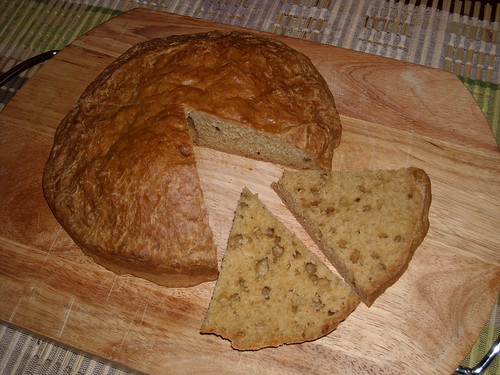 Today, in deference to my wife as I don't like it very much, I made soda bread, which is a bread made without yeast and using bicarbonate as the raising agent. Its advantage is that it is relatively quick to make, though it takes a while to cool, so it can be made in the morning without any activity the evening before (I watched a film that finished late last night).
Today, in deference to my wife as I don't like it very much, I made soda bread, which is a bread made without yeast and using bicarbonate as the raising agent. Its advantage is that it is relatively quick to make, though it takes a while to cool, so it can be made in the morning without any activity the evening before (I watched a film that finished late last night).The main thing to note with this bread is to be really gentle with the dough; you don't want to excite the gluten in the flour too much or it will end up as a very solid lump. Also try adding extra bicarb or cream of tartar and varying the liquid to achieve the consistency that you like.
The 'bonnet' mentioned in the recipe can be any metal or other ovenproof material, it does make a difference. By keeping the dough moist whilst the rising takes place, it gives it more room to breathe as it were.
You may like this bread more than me, it's a bit stodgy for my taste, if so you have an easy job bread making. If not I'm sure you will find a recipe to your taste elsewhere on the site.
Bake boldly.
Saturday 19 January 2008
Saturday Baking
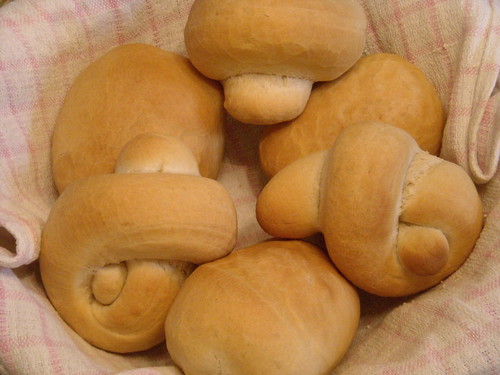 Saturday is a busy time in the kitchen, mainly because once the oven is on I have time to throw a few other things in too. Today I made a simple roll (these simple breads just keep on coming) based on pizza dough and popular in Italian bakeries on Saturdays due to their good shelf-life; they'll still taste fresh on Sundays when the bakeries are closed. For this reason, and because I made up the recipe myself before my wife informed me of this fact, I shall call it Saturday Bread and shall not provide an overnight recipe; you can adapt it yourself if necessary. To make the knotted rolls when shaping the dough, just roll out a piece of dough into a sausage shape about 30cm long and tie into a knot, as it proves it will fill out into a roll.
Saturday is a busy time in the kitchen, mainly because once the oven is on I have time to throw a few other things in too. Today I made a simple roll (these simple breads just keep on coming) based on pizza dough and popular in Italian bakeries on Saturdays due to their good shelf-life; they'll still taste fresh on Sundays when the bakeries are closed. For this reason, and because I made up the recipe myself before my wife informed me of this fact, I shall call it Saturday Bread and shall not provide an overnight recipe; you can adapt it yourself if necessary. To make the knotted rolls when shaping the dough, just roll out a piece of dough into a sausage shape about 30cm long and tie into a knot, as it proves it will fill out into a roll.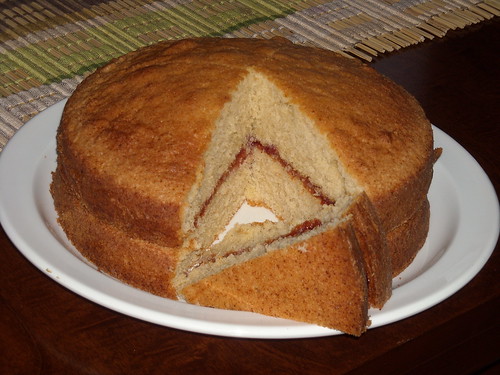
While I had the oven on I thought I would also do a simple vanilla sponge cake, especially as I had brought some vanilla essence back from Zanzibar the like of which I had never smelt before. As it turned out I could have used a little more vanilla, but filled with strawberry jam the cake itself was nice enough.
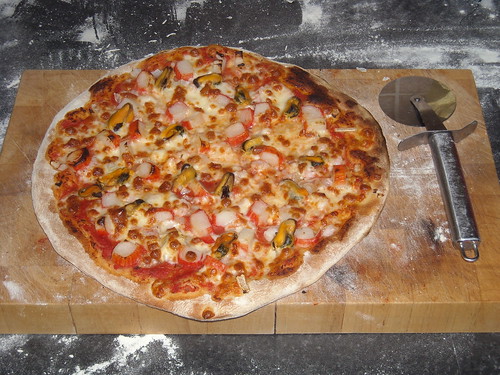 This evening I also provided pizzas for a few friends. I have included a photo here due to popular demand (Frutti di Mare, or seafood to you and me) and I shall also provide a link to the recipe as I have finally managed to write one rather than just keeping it in my head. Notes on the details of cooking and handling pizza can be found here.
This evening I also provided pizzas for a few friends. I have included a photo here due to popular demand (Frutti di Mare, or seafood to you and me) and I shall also provide a link to the recipe as I have finally managed to write one rather than just keeping it in my head. Notes on the details of cooking and handling pizza can be found here.So a busy day in the kitchen for the baker, but the products were well worth the small amount of effort involved!
Bake big.
Friday 18 January 2008
Pitta Bread
 If you thought that the previous recipe was easy then this one is going to be simple for you. Pitta bread is a popular staple in sandwiches and snacks, but the shop bought varieties are a poor reflection of home-baked pitta, made more to last than for their taste or texture.
If you thought that the previous recipe was easy then this one is going to be simple for you. Pitta bread is a popular staple in sandwiches and snacks, but the shop bought varieties are a poor reflection of home-baked pitta, made more to last than for their taste or texture.This pitta bread recipe is probably Greek in origin as many flat breads such as these are made without yeast in north African countries and the Middle East. As usual I have slightly adapted the recipe to also be suitable for overnight baking, but by now seasoned readers should be getting the hang of slowing the rising to make bread baking fit your schedule; after all we're much more intelligent than the yeast. I prefer to make mine using the half and half wholemeal/white method, but they are just as good when made with only strong white flour (I shall write a post about flour types in the near future).
The main point to note when making this bread is that it is really important to have the oven and the trays hot before baking. In order to get the breads to split properly and puff up during cooking they need a sudden and extreme rise in temperature to create steam pressure within the bread (watching them as they bake is quite entertaining).
Once made the breads can be used to make delicious sandwiches, and any leftovers can be toasted and cut into strips for dipping in old favourites such as hummus or guacamole.
Be better bread.
Wednesday 16 January 2008
The easiest bread in the world
So, being a little on the lazy side after so many days away, I made my simple bread by the overnight recipe today and formed it into baps. The photo these produced has been added to the original post at the link above so you can get an idea of how mine turned out. They were delicious with some boiled egg from my chickens (it came out normally, I boiled it) and also with ham and mustard. The remainder was immediately frozen as per my previous instructions so I can be even lazier another day.
Bake well.
Bake well.
Tuesday 15 January 2008
Crusty Bread
Today I baked my natural leaven bread, which comes out with a deliciously crispy crust. I dutifully photographed it and added the photo to the original post as linked to above. This bread is excellent with soft cheese like brie or camembert, and the leaven has kept perfectly well in the fridge while I was away on holiday.
Keep baking.
Keep baking.
Monday 14 January 2008
Where have I been?

The dearth of posts in recent weeks has been as a result of the hectic run-up to Christmas and a holiday I took to relax after a busy year. I have spent the last two weeks in Zanzibar soaking up the sun and trying to forget how cold it was in England (this is me silhouetted against the pure white sands of the east coast, paradise).
Unfortunately all this galavanting around the globe left me with little time to bake bread and no access to the internet for blogging (as if I even thought of it!), but on my return I am straight back into the fray, and the new Nikon Coolpix L15 will provide some beautiful shots of the baking process to help you along. I haven't decided whether to re-post or just bake, photo and go back to the original posts to add them; this might be better for new arrivals to the blog.
So the first thing I baked back in Blighty was based on the baps recipe I posted previously as a simple bread, but this time I formed it into a bloomer by taking it after the first rising and forming a round, folding in the 'corners' to hold the loaf together and then rolling up and coating with sesame seeds for a nutty flavour (leave the seam-side down).



Slashing the top just before baking allows more rising as the crust doesn't restrict its movement; make the slashes with a very sharp knife (preferably razor blade) and in one quick movement across the bread, really quick, otherwise it just gets caught up in the dough.


Subscribe to:
Posts (Atom)